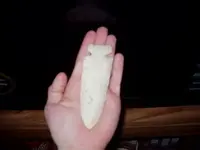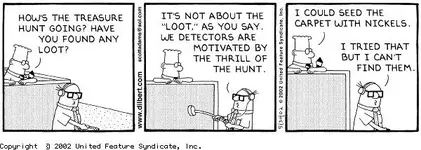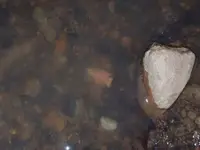You are using an out of date browser. It may not display this or other websites correctly.
You should upgrade or use an alternative browser.
You should upgrade or use an alternative browser.
Another arrowhead!
- Thread starter badandy
- Start date
krimic
Full Member
WOW that sucker is huge.. I couldn't imagine finding something quite like that just the history that you are holding in your hand alone is enough to make you smile... Nice find man, Krimic
D
Deadshot
Guest
Nice point. Being that big would it be considered a spear point? I cant really see that being shot with a bow.
Deadshot
Deadshot
cheese
Silver Member
Actually, most all "arrowheads" are actually more or less what you might call spear heads. The bow and arrow are very recent in the history of man. The above point predates bow and arrows and would have been either a knife or it would have been attatched to a spear-type shaft that was thrown with another piece of wood with a hook or socket in the end called an atlatl. The atlatl was about as long as the users arm, and gave the user more leverage to propell the spear with more speed and force. Just my two cents as an amature archaeologist.
Monty
Gold Member
- Joined
- Jan 26, 2005
- Messages
- 10,746
- Reaction score
- 167
- Golden Thread
- 0
- Location
- Sand Springs, OK
- Detector(s) used
- ACE 250, Garrett
- Primary Interest:
- All Treasure Hunting
Beautiful piece, almost perfect. I can just see those brown hands striking that flint and forming a true treasure. There's got to be a heaven so you can meet with him some day and discuss finding it! JIM
muddyknees
Sr. Member
- Joined
- May 5, 2005
- Messages
- 450
- Reaction score
- 3
- Golden Thread
- 0
- Location
- Holden Beach,North Carolina
Beutiful, I have broken pices like that one realy good to see one whole.
muddyknees
muddyknees
badandy
Hero Member
- #8
Thread Owner
Thanks everybody! Cheese nailed it on the head, it was used as a knife because it has a bevel on both left faces of the blade. I did not find it though I bought it and payed a good price as well.........I did decide to buy it at the show so in a sence I guess you could say I found it LOL! Here is a pic of my beat personal finds from 2004, the big blade in the center is the same size as the Thebes for size comparison. Thanks again!
Attachments
ibbasser123
Full Member
- Joined
- Feb 9, 2005
- Messages
- 117
- Reaction score
- 1
- Golden Thread
- 0
- Location
- Kansas City
- Detector(s) used
- 1500 Garrett
that is one nice collection!!! it is neat to think about the history behind each one. i guess thats why we all enjoy what we do! just thinking where when who and why!! have a great day and keep on keeping on.
chuckered
Jr. Member
Very nice collection, I'm green with envy, keep up the great work.
DugHoles
Bronze Member
- Joined
- May 23, 2005
- Messages
- 1,230
- Reaction score
- 8
- Golden Thread
- 0
- Location
- Hudson Falls, NY
- Detector(s) used
- White's Spectrum XLT---Tinytec Ultraluxe probe
Fish-Head Aric
Greenie
awesome collection indeed! How long have you been working to accumulate such a fine and varied selection?badandy said:Thanks everybody!? Cheese nailed it on the head, it was used as a knife because it has a bevel on both left faces of the blade. I did not find it though I bought it and payed a good price as well.........I did decide to buy it at the show so in a sence I guess you could say I found it LOL! Here is a pic of my beat personal finds from 2004, the big blade in the center is the same size as the Thebes for size comparison. Thanks again!
kdummett
Greenie
The artifact looks great. The only caveat I can give you, especially when you purchase such items, is to have the piece authenticated by a professional archaeologist or museum curator. I am an Archaeologist. Shows or swap meets are notorious for selliing replicas made by someone trained in flint napping. I have seen many of these knock offs. The one thing that makes me wonder about the atiquity of the piece is the notching at the base. Pieces this size were usually used as a knife or more likely than not as a ceremonial object. Things this size are not hafted onto a shaft using this method. The main problem about buying from a show is, you don't have any information about context. Without knowing that it is impossible to date the piece. There are some hints as to age but those can be reproduced by modern methods. Not that I am trying to burst your bubble. You may well have a genuine artifact. I only am trying to point out that buying as opposed to collecting on your own opens you up to the fraud that is rampant with swap meets and shows.
I might be able to shed some light on this particular piece if you know something about the general area where it was found. One thing for sure it is not an archaic phase implement. If it is a genuine artifact it would have been made recently, more towards the 19th century.
Cheers
I might be able to shed some light on this particular piece if you know something about the general area where it was found. One thing for sure it is not an archaic phase implement. If it is a genuine artifact it would have been made recently, more towards the 19th century.
Cheers
kermit
Hero Member
- Joined
- Aug 9, 2005
- Messages
- 545
- Reaction score
- 69
- Golden Thread
- 0
- Location
- Mississippi
- Detector(s) used
- Whites V3I, AT PRO, Garrett Pro-Pointer AT
- Primary Interest:
- All Treasure Hunting
I don't know much about it but it sure is a nice arrowhead
Kermit
Kermit
Johnny X
Bronze Member
- Joined
- Aug 18, 2005
- Messages
- 1,178
- Reaction score
- 444
- Golden Thread
- 0
- Location
- Jerseyville Illinois
- Detector(s) used
- White's Spec. XLT..... My Eyes
beautiful point andy,
I have only 1 thebes point and it's more short and round. Your's sure is a beauty though. Keep up the good hunting.
Steven
I have only 1 thebes point and it's more short and round. Your's sure is a beauty though. Keep up the good hunting.
Steven
Kent in AL
Sr. Member
- Joined
- Mar 21, 2003
- Messages
- 481
- Reaction score
- 5
- Golden Thread
- 0
- Location
- N. Alabama
- Detector(s) used
- Minelab Equinox 600, Fisher CZ-6a, ID Edge
- Primary Interest:
- Metal Detecting
That is beautiful! I picked up a lot of arrowheads as a kid when our farm was partially cultivated. Now it's all pasture so no more arrowhead hunting. 
Kent

Kent
K
Kentucky Kache
Guest
Very nice blade. My book says $325-375.
cheese
Silver Member
What?? More towards the 19th century?? Not an archaic implement? Please explain.
If this is authentic, then it would be a piece from just after paleo times...in the early archaic ages...roughly 8 to 10 thousand years old. I can't tell for sure from the picture, but the flaking style definitely doesn't appear to be anything close to resembling anything from the woodland or mississippian ages, which would be the last flaking styles used by native americans before entering the historic period, which you are stating this is from.
I know of no point type that was ever copied again by native americans in historical years except for modern day artists. The point shown is consistent with the thebes type, and the bevel on the left side is a common trait with that type point. It ocurrs with resharpening. The notches look to be normal for the type, and the material appears to be consistent with most points from the northern central united states, which is where this point type is found. Illinois, Iowa, and Missouri being the area with most concentration. Thebes points are typically larger points...probably averaging somewhere around 3 to 4 inches long. Many examples are longer.
I am a novice when it comes to metal detecting, but I am pretty sure footed in archaeology, specifically the lithics industry. If I am overlooking something that points to the 19th century, please educate me. Otherwise, I'd say this is a typical point for the type and area, and is either authentic, or reproduced by an artist who has mastered the technique, flaking styles, and has great knowledge of the proper materials and designs for the point type. If it is a repro, it is high quality. No repro can pass for authentic with proper inspection, most being readily identified as repros to the trained eye. Other repros made with painstaking efforts to duplicate authenticity may take more than a visual examination.
If this is authentic, then it would be a piece from just after paleo times...in the early archaic ages...roughly 8 to 10 thousand years old. I can't tell for sure from the picture, but the flaking style definitely doesn't appear to be anything close to resembling anything from the woodland or mississippian ages, which would be the last flaking styles used by native americans before entering the historic period, which you are stating this is from.
I know of no point type that was ever copied again by native americans in historical years except for modern day artists. The point shown is consistent with the thebes type, and the bevel on the left side is a common trait with that type point. It ocurrs with resharpening. The notches look to be normal for the type, and the material appears to be consistent with most points from the northern central united states, which is where this point type is found. Illinois, Iowa, and Missouri being the area with most concentration. Thebes points are typically larger points...probably averaging somewhere around 3 to 4 inches long. Many examples are longer.
I am a novice when it comes to metal detecting, but I am pretty sure footed in archaeology, specifically the lithics industry. If I am overlooking something that points to the 19th century, please educate me. Otherwise, I'd say this is a typical point for the type and area, and is either authentic, or reproduced by an artist who has mastered the technique, flaking styles, and has great knowledge of the proper materials and designs for the point type. If it is a repro, it is high quality. No repro can pass for authentic with proper inspection, most being readily identified as repros to the trained eye. Other repros made with painstaking efforts to duplicate authenticity may take more than a visual examination.
badandy
Hero Member
- #19
Thread Owner
O.K. here we go, The point in question has a Roy Motley authentication paper from 07-16-04 and was papered for Dale Rutherford, which is who I bought the point from. Roy says it's good and is very good with lithics from around this area. The paper says it was found in St. Charles., Mo. and the registration no. is 07-5513-04. I have also seen many fakes and the A**holes making them are getting better. I usually do not buy expensive points anymore without an authentication paper already issued for it cause it's not worth the hassle. Here is Roy's #1-816-229-6025 if anyone would like to contact him.
Thanks Fish-head Aric!, I have been hunting arrowheads since I was around 12 or so and that pic. is what I found just in 2004. I will soon have my 2005 frame complete sometime after the new year and will post pic. of it then. Here is another pic. of the best Hopewell I have found this year so far. There are lots more in the frame, but you'll still have to wait! LOL! P.S. It's an in-situ photo!
Thanks Fish-head Aric!, I have been hunting arrowheads since I was around 12 or so and that pic. is what I found just in 2004. I will soon have my 2005 frame complete sometime after the new year and will post pic. of it then. Here is another pic. of the best Hopewell I have found this year so far. There are lots more in the frame, but you'll still have to wait! LOL! P.S. It's an in-situ photo!
Attachments
Johnny X
Bronze Member
- Joined
- Aug 18, 2005
- Messages
- 1,178
- Reaction score
- 444
- Golden Thread
- 0
- Location
- Jerseyville Illinois
- Detector(s) used
- White's Spec. XLT..... My Eyes
Woo! Keep em coming andy!!!!
HH
Steven
HH
Steven
Similar threads
- Replies
- 4
- Views
- 730
Users who are viewing this thread
Total: 1 (members: 0, guests: 1)











